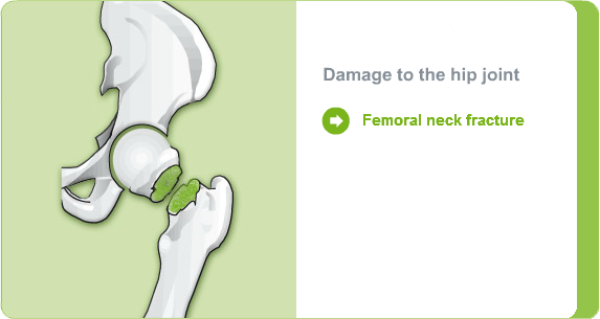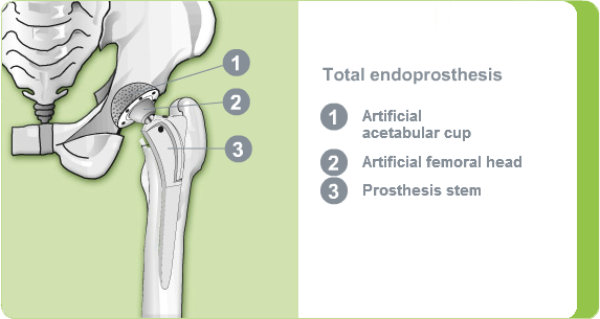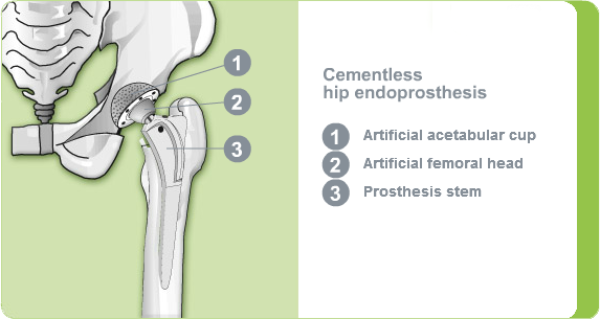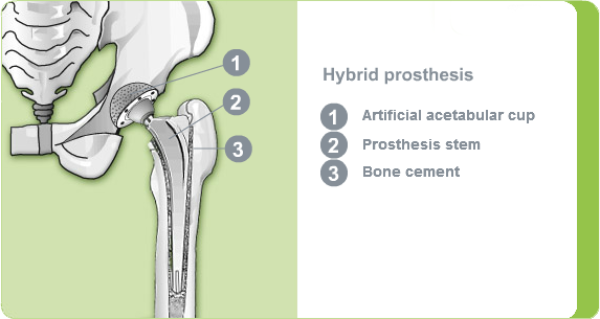The Hip Joint
Learn more about the anatomy and damage of a hip joint, the fixation of an artificial hip joint and what happens before the surgery.
Anatomy: How is the Hip Joint Structured?
The hip joint is made up of two bony sections:
- femoral head: globular end of the femoral neck
- acetabulum: cup-like cavity in the pelvis bone
When in a healthy condition, both joint surfaces are covered with a layer of joint cartilage that acts as a kind of shock absorber. It helps to distribute and reduces the forces which act upon the hip joint. This surface is lubricated by synovial fluid. The synovial fluid enables smooth movements of the bones and reduces friction. The fixed joint capsule forms an envelope around the hip joint.
Stability and Movement Thanks to Ligaments and Muscles
It is the bony structure which makes this joint so stable: The femoral head rests securely in the amply sized concave acetabulum. The hip joint is also reinforced by strong ligaments. The joint is surrounded by strong muscles which help protect it and allow a powerful movement of the legs.
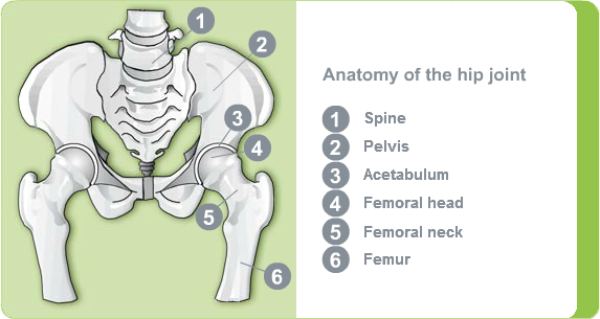
Damage of the Hip Joint - What Causes Damage to the Hip Joint?
Friction and pain-free movement of the hip joint requires the joint cartilage on the femoral head and acetabulum to be intact. A variety of factors can cause wear or damage to the protective cartilage layer, known as coxarthrosis.
In healthy hip joints, the joint cartilage forms a smooth surface and thus friction between the joint surfaces is kept to a minimum.
In the case of coxarthrosis, however, the joint cartilage initially loses its elasticity, although the patient is unaware of this. The surface of the cartilage becomes rough in the areas subject to the greatest loads and, over the course of time, is completely worn away. The bony surfaces of the joint now rub against each other which can ultimately result in deformation of the femoral head and acetabulum.
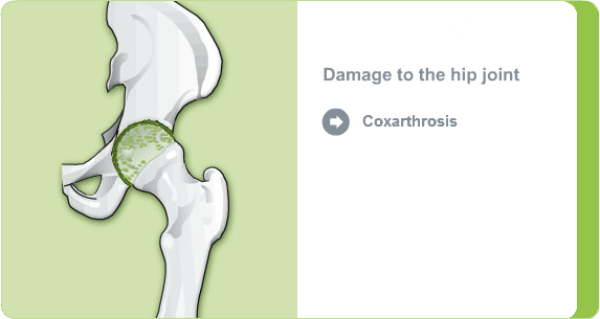
Pain and Restricted Movement
If the joint surfaces rub against each other without the protective layer of cartilage, this will result in pain. Initially, the patient only notices the pain when the joint is loaded, yet over the course of time, pain is increasingly experienced when the joint is not loaded, particularly at night. The most pain is experienced in the groin area but can also radiate to the front of the femur.
The pain and subsequent muscular tension compromise articulation of the joint: since the hip joint plays a key role, particularly in day-to-day activities such as sitting and walking, patients are increasingly restricted in their everyday lives and experience diminished quality of life. Even putting on socks and shoes, climbing the stairs or getting out of bed can become a challenge.
Pain Relief Options
Depending on the nature of the pain experienced, the attending doctor will at first try conservative methods to ease the pain. These include pain relief and anti-inflammatory medication, physiotherapy, baths and packs. These help to reduce the pain and improve joint mobility.
However, there is currently no proven method for curing hip osteoarthritis. Therefore, if all conservative measures do not lead to pain relief, the use of an artificial hip (hip arthroplasty) is recommended by the surgeon.
Artificial Hip Joint - How Does it Work?
The artificial prosthesis components are made of different materials:
- metal alloys (titanium alloys in particular, due to good tolerance and durability)
- ceramic and special plastic polymers
(imitation of the lubricative cartilage layer)
The surgeon will decide which materials to use depending on the patient's anatomy.
If the cartilage layer in the acetabulum is in good condition (for example after a femoral neck fracture), it does not need to be replaced. In such cases, only the femoral head and the femoral neck are replaced with an artificial femoral head on a prosthesis stem. Following the operation, the artificial femoral head sits in the natural acetabulum. This is referred to as a partial hip replacement or partial hip arthroplasty.

Fixation Artificial Hip Joint - How is the Hip Prosthesis Fixated?
An artificial hip joint can be fixated to the bone in a number of different ways. In essence, there are two main types of fixation – with bone cement or without bone cement:
- If the bone structure lacks stability, the hip joint replacement is fixated using bone cement. Immediately after the operation, the hip endoprosthesis and bone are thus securely bonded.
- If the patient’s bone is of good quality, the artificial hip joint can be fixated using a cementless technique. With such methods, the bone slowly grows into the hip endoprosthesis to form a strong joint after some time.
The correct choice therefore not only depends on the patient’s age but also on the nature of the bone. The surgeon decides upon the appropriate method together with the patient during the preoperative discussion.
With this method, the artificial acetabular cup and the prosthesis stem are bonded to the bone using bone cement.
For older patients, in particular, the use of bone cement for securing hip replacements is often advisable. The slow bony ingrowth process of the artificial hip joint is avoided and the patient is able to load the leg again soon after the operation.
Furthermore, major studies have shown that cemented hip replacement is particularly durable. This may prevent the necessity of a second operation to change the prosthesis, or at the least postpone it.
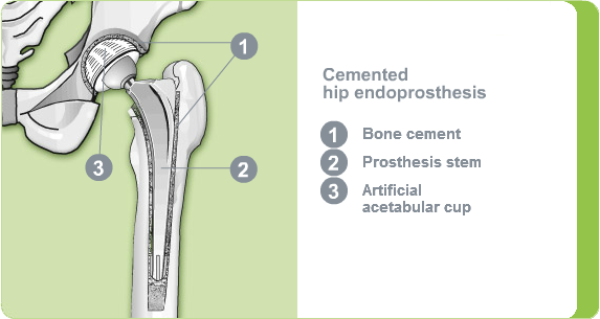
What Happens Before the Surgery?
Physical Examination – where Does it Hurt?
The doctor will first examine your pelvis, both hips, spine and legs and, when doing so, will palpate various muscles and bone structures. He will then perform a few movement tests in order to gain an impression of the mobility of the hip joint. He further examines the pain caused when the hip joint is moved in different directions, for example adduction, abduction, rotating, bending and stretching. At the same time, the doctor also examines to see if there is a difference between the length of the legs.
Patient Assessment – Your Personal Medical History
Your doctor will first ask you to give details of your complaints. He will want to know where it hurts and where the pain radiates to. He will also ask about the intensity of the pain, its duration and any factors which intensify or ease the discomfort.
X-ray – Focus on Your Hips
Using the X-ray image, the doctor is able to recognise the changes caused by coxarthrosis: the intra-articular space between the acetabulum and the femoral head is either no longer uniform, is narrower or indeed is no longer visible. The bone structure of the femoral head and acetabulum appears irregular and altered whilst in very advanced stages the sections of the joint are deformed.
Preoperative Discussion – Your Chance to Ask any Questions
On the day before the surgery, the surgeon will usually talk to you in detail about the planned procedure. He will explain the surgical method and the type of prosthesis to be used. The prosthesis model selected depends on the nature of your bones, your body weight and your level of physical activity. The surgeon will have normally decided beforehand which prosthesis model and type of fixation to use on the basis of your X-ray and data.
In the majority of cases, the surgeon will also ask you about your state of health on the day before the surgery. Do not hesitate to inform your doctor of any complaints which you consider minor, such as colds and skin infections, even if you are not asked. Although harmless, these illnesses need to be cured before a surgical intervention.
The anaesthetist will also talk to you on the day before the surgery to explain the potential risks involved with the anaesthesia. He will perform a few minor examinations; he is particularly interested in your heart and lung functions and any possible allergies. He will then talk to you about the type of anaesthesia to be used.
Autologous Blood Donations – Find out More!
Under certain circumstances, large amounts of blood may be lost when performing a hip prosthesis surgery. A blood transfusion then becomes necessary. An autologous blood transfusion using the patient's own blood which was donated at an earlier date, essentially rules out the risk of infections such as Hepatitis C and HIV.
As a rule, there is sufficient time between the diagnosis and the hip prosthesis surgery (around two to six weeks) to discuss this issue with your attending doctor. Use this opportunity to ask about the option of an autologous blood donation.
